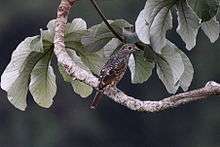Blue cotinga
The blue cotinga (Cotinga nattererii) is a species of bird in the family Cotingidae. It is found in Colombia, north-west Ecuador, eastern and central Panama and western Venezuela in tropical moist lowland forests and heavily degraded former forest. In relation to range and population size this species is not considered to be vulnerable.[2]
| Blue cotinga | |
|---|---|
.jpg) | |
| Male | |
| Scientific classification | |
| Kingdom: | Animalia |
| Phylum: | Chordata |
| Class: | Aves |
| Order: | Passeriformes |
| Family: | Cotingidae |
| Genus: | Cotinga |
| Species: | C. nattererii |
| Binomial name | |
| Cotinga nattererii (Boissonneau, 1840) | |
Description

The blue cotinga is a plump, dove-like bird with a small head.[3] It grows to a length of about 7 inches (18 cm). The male has glossy blue plumage and a black bib with a purple iridescent sheen on the throat and breast. There is a black ring round the eye, and the wings and tail are black with broad blue margins. On the belly there is a circular patch of purple. The female looks quite different; she is dark brown above, each feather having a pale margin which gives the bird a scaly appearance, and the underparts are pale brown with each feather having a buff margin.[4] The turquoise cotinga (Cotinga ridgwayi) is a similar species with which this bird might be confused, but it has a different range.[4]
Distribution and range
This species is native to Central America and South America. Its range extends from central Panama southwards to northwestern Ecuador and Venezuela. It occurs on the borders of moist woodland, in the canopy of primary forest and in tall secondary forest. Its altitudinal range is up to about 900 metres (3,000 ft).[4]
Ecology
The blue cotinga lives high in the canopy. It is mostly a solitary bird, but may sometimes be seen in groups on a fruiting tree; the diet consists of fruit, plucked while hovering briefly. The male often sits in a stationary position on a high perch on an emergent tree, under which conditions his brilliant blue colour may be indiscernible while he is silhouetted against the sky. This bird does not seem to have a song or call, but the male may, while in flight, make a whirring or rattling sound with his wings, perhaps a form of display.[4]
Status
C. nattererii has a very wide range and is described as fairly common. For these reasons, the International Union for Conservation of Nature has rated its conservation status as being of "least concern".[1]
References
- BirdLife International (2012). "Cotinga nattererii". IUCN Red List of Threatened Species. 2012: e.T22700877A38656058. doi:10.2305/IUCN.UK.2012-1.RLTS.T22700877A38656058.en.
- Cotinga nattererii Birdlife International
- Hilty, Steven L.; Brown, Bill (1986). A Guide to the Birds of Colombia. Princeton University Press. p. 451. ISBN 0-691-08372-X.
- Ridgely, Robert S.; Gwynne, John A. (1989). A Guide to the Birds of Panama: With Costa Rica, Nicaragua, and Honduras. Princeton University Press. p. 321. ISBN 0-691-02512-6.
